| 1 | The world’s shortest python |
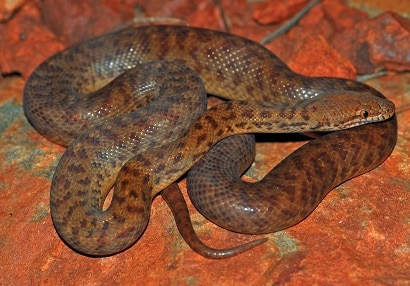
Worldwide, the Pythonidae family of pythons has at least 41 members. The reticulated python of Thailand is the longest, and the longest of any snake worldwide, with a wild record of 6.95 meters. At the other extreme, you can find the world’s shortest python: the pygmy python, AKA Anteresia perthensis.
This small species lives in parched western Australia, and begins life at just 17cm. It peaks at an average adult length of 40-60cm, easily making it the shortest python worldwide, assuming there isn’t a miniscule underground species which scientists haven’t discovered yet. The second smallest species is the closely related children’s python (Anteresia childreni), which lives further east in Australia, but peaks at a much larger 1.4 metres.
The pygmy python lacks any flashy colours. It’s a red-brown colour, but a dull brick red rather than a flashy lava red. Its body features dozens of small spots, but these are very similar in colour to the main scales, and difficult to distinguish. In fact, these spots sometimes look more like grubby human fingerprints.
As youths, pygmy pythons are slightly brighter, with more noticeable spots, but these fade into dullness by adulthood. There’s a clear purpose to this dullness though: bright green scales would have terrible camouflage in the parched Australian outback, causing hungry predators to swoop down in no time.
| 2 | Location: parched Pilbara |
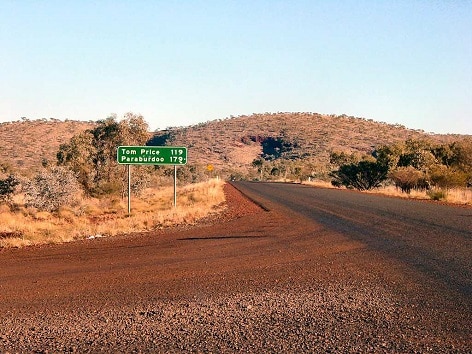
In the far northwest of Australia, there’s a surprising coastal paradise called the Kimberley tropical savannah, where the grass grows plentifully, and the boab trees are extremely thick. This oasis benefits from being adjacent to the Timor sea, and closely resembles an African savannah. It’s full of hopping mammals such as wallabies, wallaroos and kangaroos, and there’s even pockets of monsoon rainforest.
Move further south though, and the habitat suddenly morphs. This is Pilbara region, a semi-arid slice of western Australia just north of Perth. Pilbara was once the epicentre of the Australian gold rush, and is home to Marble Lake, the hottest inhabited town in Australia, with 174 citizens.
This is a red, barren land where the greenest things you can see are the distant road signs on the horizon. There are few trees in Pilbara other than stunted eucalyptus, and the majority of plants are thin, dry spinifex bushes. Somehow though, the pygmy python manages to eek out an existence here. It isn’t an easy life, and sometimes the pygmy python is forced to take shelter from the burning heat in strange places (see below).
Despite their Latin name of perthensis, pygmy pythons come nowhere close to Perth. They’re resolutely a species of old parched gold mining country. If you want to find a pygmy python in the wild, you have a harsh trek on your hands.
| 3 | Hides in anthills |
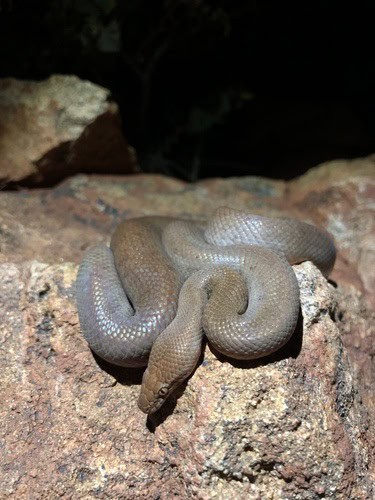
The pygmy python also has the nickname of anthill python, due to its habit of taking shelter in termite mounds. These hidey holes give the snake a ready-made shelter against the blazing sun of Pilbara. As nocturnal snakes, pygmy pythons sometimes spend every daylight hour inside them. They’re not dependent on termite mounds to survive, as they also use spinifex bushes for shelter.
Nevertheless, it’s said that whenever biologists want to catch this species, they’ll simply turn up with heavy machinery and demolish one or two mounds. Pygmy pythons also share these mounds with other Pilbara snakes, including black-headed python, king brown snakes, and Stimson’s pythons. Not only do these species coexist peacefully without eating each other, but they’ll sometimes curl up together into a large snake ball. Their goal is probably to save space, unless they simply enjoy creating a giant snake ball.
And in case you’re wondering – no, these snake balls aren’t known to break loose and roll uncontrollably through the outback.
| 4 | Extremely large eggs |

The pygmy python leads a solitary life, with the exceptions of snake ball happy hour and mating season. Females have to think very strategically in the roasting outback, and usually lay their eggs beneath, dry shady rocks. They lay only 2 to 5 eggs at once, but for mysterious reasons, their eggs are extremely large. They also have a parchment-like texture, yet a thin shell. After laying, the mother pygmy python coils around her eggs for 50 days, while the yolk inside bubbles away to create a hatchling.
Pygmy pythons are very common within their known ranges in Pilbara. In fact, given the vastness of the outback, some herpetologists believe that they’re flying under the radar and have secret, unknown colonies further east.
Right now, its eastern boundary is considered to be the Canning Stock route that cuts through central Western Australia. It’s also an island-dwelling snake, living on the Dampier archipelago in Pilbara’s far north.
| 5 | Hunts bats using stealth |
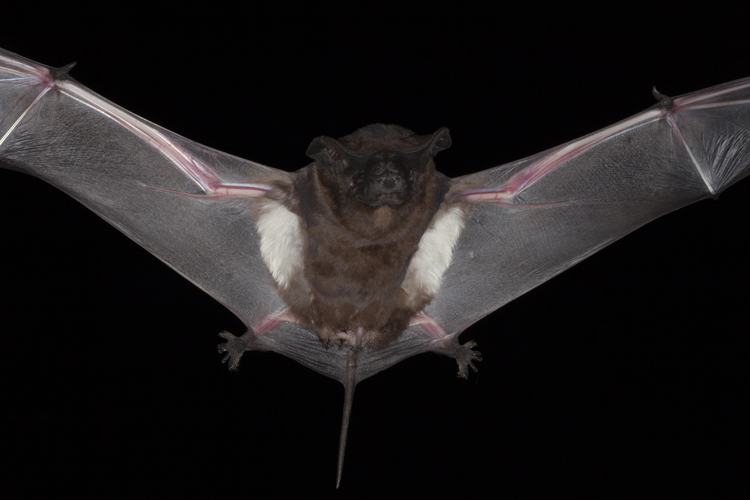
The pygmy python is a non-venomous constrictor. Foraging would be far too exhausting in the dusty landscape of Pilbara, so instead, the pygmy python takes the path of least resistance – ambush tactics. Its strategy isn’t to wait in grass (because there isn’t much), but in spinifex hummocks, the hard core of thick, spiky bushes raised above ground. This makes them invisible to prey walking past.
Pygmy pythons mainly prey on skinks and geckos, but also small mammals, one example being bats. Pilbara is hilly in places, and has many remote caves. When a pygmy python catches the scent of a bat colony, it will position itself directly outside the gloomy entrance. As the sun begins to set, the snake will wait for bats to fly from the cave in huge numbers, before seizing them from mid-air with its piercing fangs, as the other bats flap around its body relentlessly.
It’s not all fun and picnics though: the pygmy python has confirmed predators of its own, including the 2 metre long king brown snake.
| 6 | A popular captive snake |

Being so lazy, the pygmy python has a healthy advantage in captivity. Natural foragers such as cobras tend to get anxious and depressed, even refusing food, but the pygmy python is happy to sit still much of the time, as long as it’s exercised regularly. It’s only a small leap from a dark termite mound to a carefully crafted reptile enclosure.
In the first few weeks, hatchlings are notoriously delicate, and require a lot of persuasion to start eating. But once they’ve warmed up to the fuzzy or pinkie mice constantly dangled in front of them, the species can have a limitless well of hunger. They can gobble down animals which are far too big for them and regurgitate them, or eat when their stomach is already bursting. Despite preferring reptiles, they’re not a fussy eater, as one forum snake breeder reported a 100% success rate for feeding the species rodents.
| 7 | Easily lives for 20 years |
Pygmy pythons can last for decades in captivity. One gritty and determined pet blasted through the 25 year barrier and it’s common for captivity snakes to reach 20. The educated guess for wild pygmy pythons is 20 years, although establishing the real age would require stalking them through the outback for decades (or using minuscule microchips).
Snake breeders have several interesting tricks for this species. One is adding rocks to mimic the snake’s environment, and keep it mentally healthy, but also securing those rocks enough that they don’t roll over and kill the snake. Another is keeping a water bowl in the cage at all times, but making sure that this doesn’t affect the cage’s humidity, as pygmy pythons require bone dry air at all times.
One advantage is that pygmy pythons are rarely affected by parasites, the opposite of the South American bushmaster. Reptile expert Raymond Ditmars was obsessed with the bushmaster, but whenever he brought one home to Bronx Zoo in New York, it died within weeks (including famous snake Lecky).
| 8 | 2015: smuggling scheme foiled |
One downside to being cosy in captivity is that other countries want a piece of the pie. Smuggling is a big problem for the pygmy python, as seen in 2015, when a gang of 2 Russians and 2 Czechs was foiled at Perth International airport. They were accused of having 150 smuggled reptiles stashed in their luggage, 20 of which had already died from stress. These included geckos, skinks, frogs and pygmy pythons.
The parcels reached the airport from Carnarvon, Tom Price and Geraldton, but eagle-eyed postal workers noticed several peculiarities (slithering sounds perhaps?). The reptiles were stored in hollowed out books and cigarette packets like a cold war spy scheme, but the plan was foiled, and the traffickers were set to face 10 years in prison. Pygmy pythons are a protected species under Australian law.
Unlike the corn snake and its endless sweet shop of colours, the pygmy python has very few morphs. One of the few to exist was a pearl pygmy python from Denmark, where an attempt to create an albino version led to pink instead.
| 9 | Not to be confused with… |
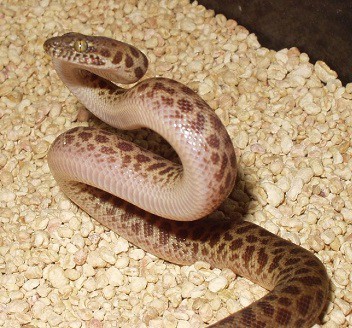
The pygmy python is a member of the Antaresia genus, which is collectively dubbed the children’s pythons after their small size. Confusion is rife, as in some Australian towns, other species are colloquially called the pygmy python instead.
One is Antarasia maculosa, AKA the spotted python. This version also inhabits northwest Australia, and is significantly longer at 1-1.4 metres. The real key is its significantly sharper patterns. The spotted python’s dark spots stand out clearly against the beige base, while the pygmy python has much less distinct boundaries. The colours are also closer to a leopards’ rather than a dull brick red. Occasionally, there’s even rainbow varieties that gleam in the light.
The spotted python is the only Antaresia member to coexist with real pygmy pythons. Originally, its Pilbara colonies were believed to be a separate species (Stimson’s python), but in 2020, this ceased to exist and was filed as a mere Antaresia maculosa subspecies.
The 2nd pygmy pretender, meanwhile, is the children’s python (Antaresia childreni) from northern Australia, which is 1-1.5 metres long and also a lighter beige colour (see picture above). Fortunately, this fake pygmy python lives nowhere near the real one.
| 10 | More prehistoric than most |
Like other pythons, the pygmy python is a particularly primitive snake. Under an x-ray, you can see the the evolutionary links to their four legged lizard ancestors, such as small remnants of hind limbs called spurs. They also have two lungs, whereas the majority of snakes have only one to accommodate their thin body shape.
Pythons have far more leftover genes which once triggered limb development compared to other snakes, as do boas. In animals, there’s a gene cluster called the “sonic hedgehog” gene which creates the initial thin spike of limb development seen in the womb, including in human babies. Pythons have these genes, but also have mutations which block their activators. Some of the activators do still function, with the result that the limb growth begins, but then flickers and stalls.
Vipers and cobras are more advanced snake families and are missing these Sonic the hedgehog genes altogether. These findings were announced in 2016, and the scientists were surprised at how prevalent the genes were in pythons after so many millions of years.
